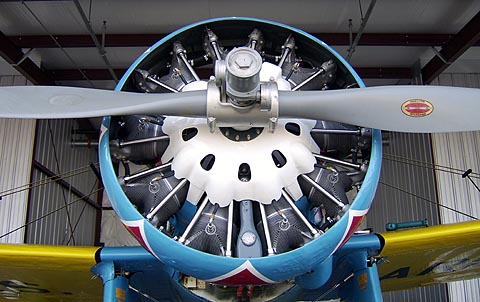

Home | About Mayocraft | Video | Contact
Fitchburg,
Massachusetts – Mayocraft Inc., completed
construction and flight-testing of its P-26D, a
near-100 percent scale tribute to the Boeing P-26 aircraft, a
long-forgotten but seminal aircraft design of the 1930’s. (An overview of prior projects is also available.) The Mayocraft P-26D is now on display at the Military Aviation Museum in Virginia Beach, Virginia. Although not an exact replica, the aircraft is generally patterned after the famed Boeing P-26 “Peashooter” an interwar aircraft built for the pursuit of other airplanes, hence the “P” designation. “ We tried to be faithful not only to the overall appearance of the P-26, but also to most of the fabrication methods at the time of its manufacture,” according to Mayocraft's founder and principal. “The P-26 represented the state of the art for the early 1930’s in aircraft design, so we thought it was an eminently worthy subject for a tribute.” Indeed, for a brief time, the P-26 was the Army Air Corp’s first line pursuit fighter and the fastest of its type in the world. However, rapid advances in aeronautics at that time soon rendered it forgotten, eclipsed by more powerful designs that drew heavily on the P-26’s parentage. A few P-26’s survived into WWII, but today only two original examples remain.  An inspection of the aircraft's construction details reveals what can only be described as a labor of love. The aircraft’s all-metal skin has been carefully hand formed and shaped in many complex compound curves by Mayo in his shop, which is in essence a small aircraft factory with tools, technology and expertise straight out of the mid-1930’s. The craft has over 29,000 rivets, each painstakingly inserted, driven and made flush with the skin. The craft has about one-half million other parts, most of which had to be machined and fabricated from raw metal or cleverly adapted from existing aircraft parts. “In many cases we had three jobs to do for each piece. First, we had to devise methods to make the production tool or jig or fixture. Then, we had to use those methods to make it. And then, use the tooling or forms to make the final part we needed,” detailed Mayo.  Fortunately, Mayo brought to this daunting project his own lifelong experience in manufacturing, engineering, and rebuilding historic airplanes, both on his own and for former clients like the Collings Foundation whose fleet of vintage WWII aircraft appears at Airshows nationwide. He devised fabrication methods like pressing into hard rubber and pull-forming sheet metal, whose results mimic those from the much larger production machines that would have been found in a 1930s-era aircraft factory. Also, according to Mayo, “For safety and performance’s sake we made selected improvements. Alclad 2024-T3 aluminum was used throughout instead of the Dural of the 1930’s because the modern alloy is 20 percent stronger. The main landing gear wheels and brakes are adapted from a Cessna T-50. The engine exhaust is made from a stainless steel alloy specially formulated for aerospace applications. For a few non-structural elements, in place of metal we formed fiberglass. The engine and propeller are the same as employed in the T-6. We adapted a different airfoil shape to the wing that should make the bird a little easier to fly and land than the original. That sort of thing.” Mayo calculated that, because of these improvements and the fact that the Peashooter does not have the armament that was originally needed in the combat airplane, “ it has a performance about 10 percent better than the original.”  Last but not least Mayo credits a small but dedicated group of volunteers that have shown up at his shop at least once a week for years on end -- and one able person did many hours of CADCAM work at home. “Really, without the help of all these people, this project would have never seen completion. Or, it would have at least taken more than my lifetime!” Taxi testing commenced in September, 2006. Flight testing was completed in 2009. Extensive video was taken of all flight test regimes include the very first flight out of ground effect. For further details please see: Air Classics magazine Classic Wings magazine and specifications. |